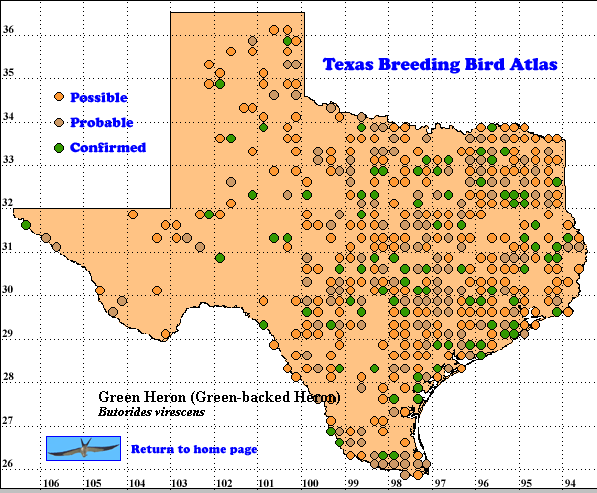The Green Heron is the most widespread of Texas herons. It inhabits a wide range of wetland habitats, both natural and human- made. Typical habitats include thickly overgrown water edges.
In Texas, an important influence on waterbird populations is the 20-25 year precipitation cycle (Telfair 2002). Between the early 1960s and the late 1980s, there was a significant upward trend in the cycle; since then, the trend has begun to decrease (Tom Spencer, Texas Forest Service, pers. comm.). The trend varies regionally and there are intermittent drought years and irregular intervals with pronounced wet/dry springs-summers such as those associated with El Niño/La Niña years and massive, slow-moving atmospheric disturb- ances (Dr. Robert K. Peters, NWS Observer for Tyler, Texas, pers. comm.). Inland wetland habitats are particularly subject to the effects of these trends. Unfortunately, there is a lack of data about the status of the Green Heron in Texas. However, Green Herons are so adaptive to so many types of wetland habitats that only extreme periods of regional drought would be adverse to their population.
Green Herons are not censused during Texas colonial waterbird nesting surveys. However, they are included in North American breeding bird surveys.
DISTRIBUTION: Green Herons are common summer residents throughout the eastern two-thirds of Texas (east of the 100th meridian), becoming uncommon westward across the Edwards Plateau and High Plains. They are uncommon and local in the Trans-Pecos region (Lockwood and Freeman 2004). Green Herons, unlike most other heron species in Texas, are more common inland than along the coast.
SEASONAL OCCURRENCE: Green Herons breed from early March to mid-July; eggs have been found from March 29-June 28 and nestlings from May 5-July 6 (Oberholser 1974). During migration, they are uncommon to common statewide. In winter they are rare
to locally uncommon along the coast and lower Rio Grande Valley and very rare inland. In this season they are, generally, absent from the Panhandle, South Plains, and Trans-Pecos away from the Rio Grande (Lockwood and Freeman 2004).
BREEDING HABITAT. Green Herons nest in various habitats that provide secluded nest sites and adjacent wetland feeding habitat, e. g., edges of rivers and streams, swamps, marshes, oxbow lakes, ponds, human-made or human-regulated water impoundments (reservoirs, ditches, canals, and ponds). These small herons often nest on islands or tree islands in marshes. They will even nest in dry woods or orchards in farmlands if feeding sites are available within 0.8 km (0.5 mi; Davis and Kushlan 1994). Green Herons generally nest in single pairs, but, sometimes nest socially in loose aggregations or in colonies. Nests are generally placed from 7-15 m (23-49 ft) apart (Kaiser and Reid 1987). When nesting in multi-species colonies, they often nest somewhat apart from other species (Davis and Kushlan 1994). Nests are usually placed over water in shrubs and trees from ground level to about 2 m (6.6 ft); but, higher nests are not uncommon at an average of 10 m (33 ft; Kaiser and Davis 1987).
STATUS: Like the bitterns and Yellow-crowned Night-Heron (Nyctanassa violacea), the cryptic coloration, secretiveness, and scattered small colonies, the Green Heron is so difficult to census that no reliable nesting census data are available. However, North American Breeding Bird Survey data for Texas (Sauer et al. 2005) give annual trends of 2.0% (1966-1979), -4.8% (1980-2005), and -1.2% (1966-2005); thus, indicating a decreasing trend; but, this may reflect survey coverage rather than a decreasing number of birds.
Text by Raymond C. Telfair II (2007)
Literature cited.
Davis, W. E., Jr. and J. A. Kushlan. 1994. Green Heron (Butorides virescens). In The Birds of North America, No. 129 (A. Poole and F. Gill, eds.). The Birds of North America, Inc., Philadelphia, PA.:
Kaiser, M. S. and F. A. Reid. 1987. A comparison of Green-backed Heron nesting in two freshwater ecosystems. Colonial Waterbirds 10: 78-83
Lockwood, M. W. and B. Freeman. 2004. The TOS handbook of Texas birds. Texas A&M. University Press, College Station.
Oberholser, H. C. 1974. The bird life of Texas. University of Texas Press, Austin.
Sauer, J. R., J. E. Hines, and J. Fallon. 2005. The North American Breeding Bird Survey, results/analysis 1966-2005. Version 6.2.2006. USGS Patuxent Wildl. Res. Cnt., Laurel, Maryland. http://www.mbr-pwr.usgs.gov/bbs/bbs.html.
Telfair, R. C. II. 2002. Inland heronries in Texas. Texas Partners in Flight Newsletter, Texas Parks and Wildl. Dept. 9: 20.

